At 44 years old, Laurent Batlles was the third-youngest manager in Ligue 2 last season and he and his ES Troyes AC side sat comfortably in one of the three promotion playoff positions in France’s second-tier prior to the premature cancellation of the competition. As a result, Troyes will compete in Ligue 2 once again next season.
Batlles took charge of his current club back in June 2019, having previously gained managerial experience as Saint-Étienne’s reserve team coach. However, the 44-year-old manager was somewhat of an unknown coming into the 2019/20 campaign.
In this tactical analysis piece, we will examine Batlles performance as Troyes manager over the past season. We will take a look at the tactics that he has deployed during his time as Troyes manager and we will attempt to explain what we believe to be some of the key aspects to Batlles coaching philosophy in this tactical analysis.
Build-up play
We will kick off this tactical analysis of Batlles by discussing his tactics during the build-up phase of play. Throughout the 2019/20 campaign, Batlles’ Troyes side were careful in possession of the ball. Only one other Ligue 2 side retained a higher pass accuracy percentage than Troyes during the 2019/20 campaign, with the Grand Est-based club playing 83.7% of their passes accurately last term.
In addition to that, Troyes played only 39.49 long passes per 90 in the league last season, which was the lowest in the division, whilst they also recorded the lowest number of ball losses in Ligue 2 last term according to Wyscout.
All of these stats indicate that Troyes tend to minimise risk on the ball, with Batlles’ side generally preferring to play carefully and rather patiently in possession, preferring to play more passes and bide their time to wait for openings as opposed to attempting to force their way through the opposition.
This element of Batlles’ philosophy was evident during Troyes’ build-up play throughout the 2019/20 campaign. Troyes play in this style from the very beginning of their attacks, starting with their own goalkeeper, who was usually 27-year-old Gauthier Gallon last season.
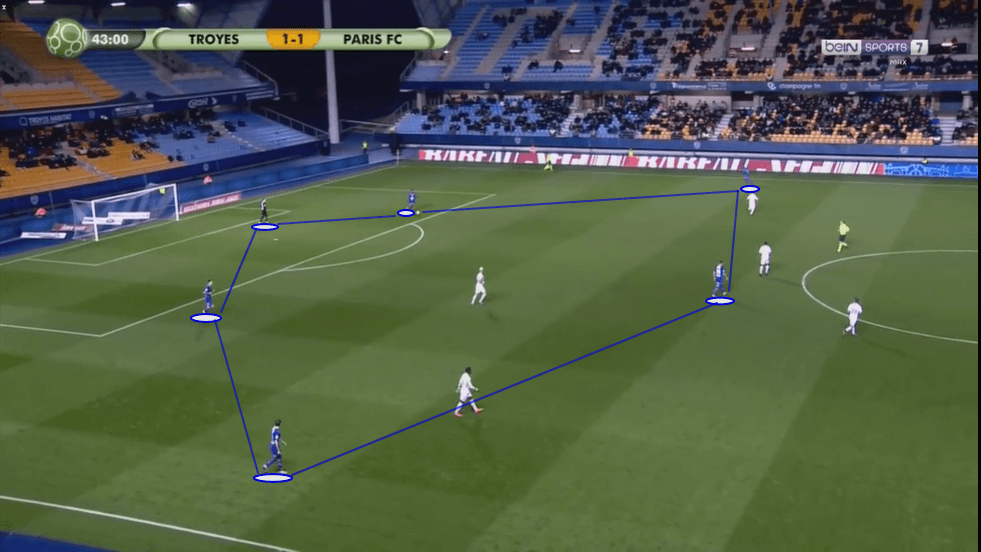
The above image provides us with an example of the shape that Troyes typically form during this phase of the build-up when their goalkeeper is in possession of the ball. Firstly, Batlles lined his side up in a 4-1-4-1 shape more often than not last season and while the coach has experimented with a variety of different formations, this one has generally appeared to be his favoured shape with this Troyes team.
Troyes’ goalkeeper needs to be fairly comfortable on the ball, as this team often relied on their goalkeeper to become somewhat of a third centre-back at times last season during the build-up. Troyes generally take their time and exhibit a great deal of patience during the build-up, however, as they play in this manner, their defenders are often forced to go back to their goalkeeper when pressed by the opposition and when progressive passing options are nullified by the opposition’s defence.
One benefit of the Troyes goalkeeper getting so involved in the build-up for his side is that this then allows their centre-backs to get wider, which then allows their full-backs to push higher up the pitch. We can see this occurring in the image above. This then forms something of a ‘2-3’ shape for Troyes within their own half during the build-up, as their two centre-backs sit closer to the goalkeeper, while their full-backs push into the next line up the pitch, taking up a position on either side of their holding midfielder.
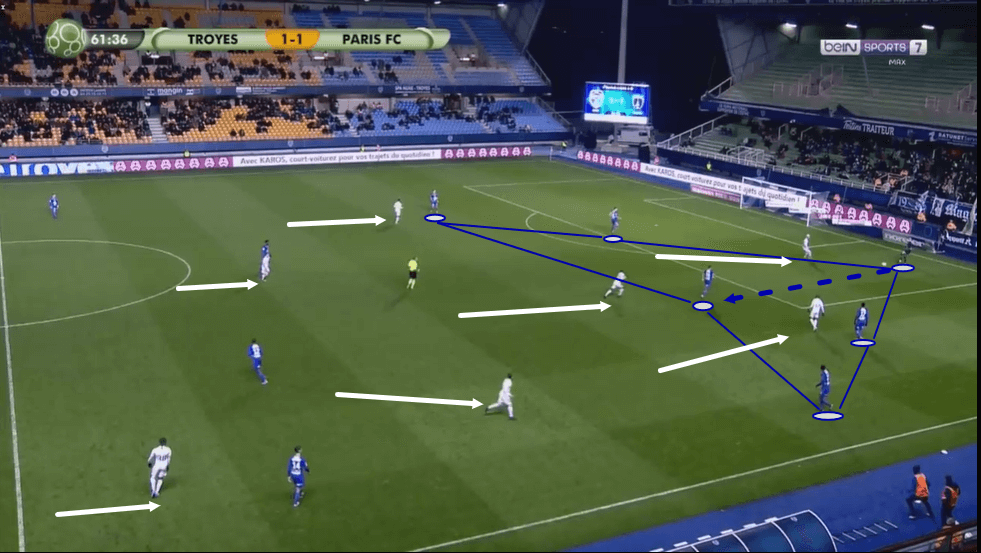
In the previous image, the opposition didn’t press Troyes particularly aggressively and they benefitted from being allowed plenty of time on the ball to create their preferred shape during the build-up. However, this next image above shows us an example of Troyes attempting to play out from the back versus a side who are pressing quite aggressively.
Even when they play against a team who press them more aggressively during the build-up, Troyes generally continue to try and adhere to their team and coach’s philosophy of playing out from the back carefully. Batlles has worked on drilling these tactics into his Troyes side throughout the season and the result, for this team, is a confidence in themselves out on the pitch to successfully play out from these deep positions, even when being put under higher levels of pressure.
In this image, we can see that Troyes’ backline has been forced to sit more compact as a result of the opposition’s press. The goalkeeper, who is in possession at this particular moment, is deep and unable to position himself to split the centre-backs, thus forcing the centre-backs to sit somewhat narrower, although, it’s important to point out that Batlles likes his centre-backs to get quite wide in the build-up regardless and as we can see, Troyes’ left centre-back has positioned himself fairly wide here, making himself more available for the goalkeeper to find in the process.
The goalkeeper plays the ball to this left centre-back, however, the defender is immediately put under pressure by the opposition player who we can see approaching him here.
This player doesn’t adequately prepare himself to receive possession and struggles to turn effectively upon receiving possession whilst still facing his own goalkeeper. As he eventually turns, he quickly plays a pass into the midfield which the opposition can intercept via their aggressive pressing.
This shows us that while Troyes will usually try to adhere to Batlles’ philosophy of playing short, careful passes in the build-up, this can backfire at times and Troyes’ defence has shown to be capable of misplacing some passes and caving under pressure, to an extent, during the 2019/20 campaign.
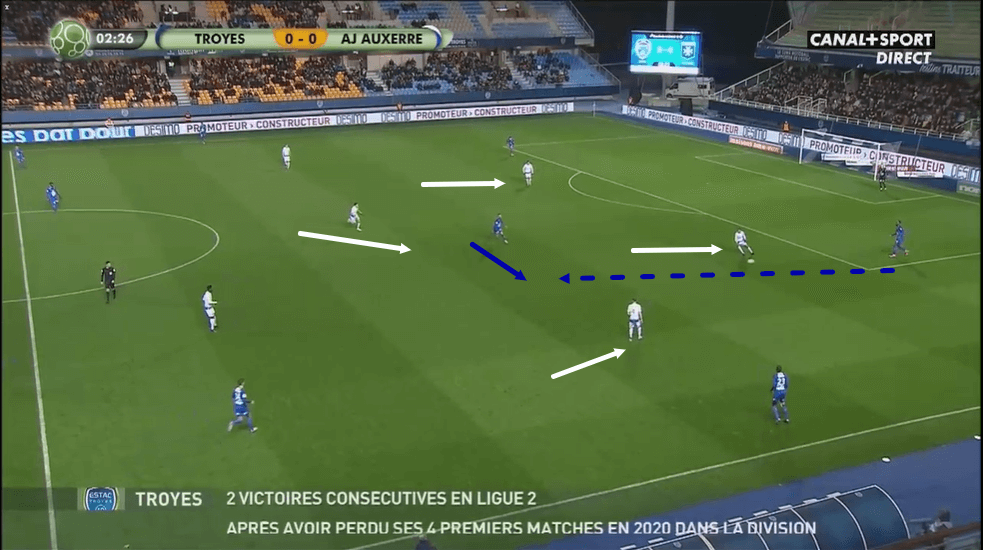
This next image shows us another example of Troyes during the build-up and while here, their opponents are pressing them fairly high, this press isn’t as aggressive or effective as the previous one and Batlles side do manage to play past the opposition’s press.
As we can see, Troyes’ centre-backs have split quite wide here again, which allows a lot of space in between the two defenders. This is quite risky as a misplaced pass could leave a big gap for the opposition to exploit and potentially get themselves straight through on goal.
However, the left centre-back in possession here just about manages to beat the opposition’s right forward with a pass into midfield to advance play past the opposition’s first line of defence and build into the middle third of the pitch.
As the centre-back plays this pass, the ball moves dangerously close to the opposition player nearest to him, which could have been quite disastrous, however, on this occasion this pass works out well for Troyes.
As the centre-backs receive the ball in these wide positions, the role of Troyes’ holding midfielder becomes important, as he has to create a passing angle for these centre-backs to utilise in order to advance play into the midfield. The holding midfielder’s off the ball movement is crucial in these situations.
When their backline is pressed like this during the build-up, Troyes’ centre-backs often play the ball into this channel just alongside the centre of midfield to play past the first line of defence and this forces the holding midfielder to shift from the centre out into this slightly wider position in order to collect the ball. This requires a quick-thinking and physically mobile player to occupy this position.
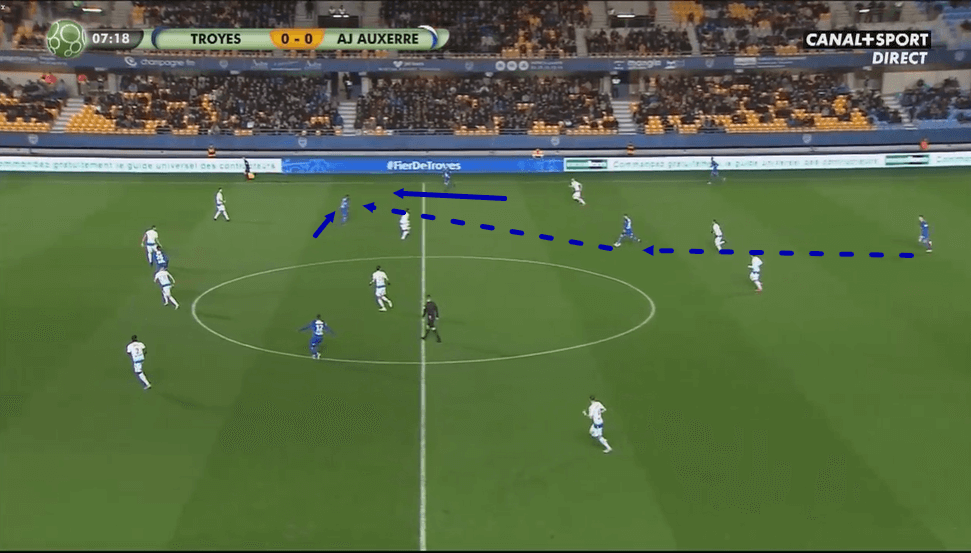
Troyes typically try to progress play from their defence into their holding midfielder, again highlighting the importance of this position within Batlles’ system. This requires this player within Batlles tactics to be quite well-rounded as he has to utilise his technical ability with regard to his role in progressing the ball for his side, in addition to good mental traits, such as positioning and scanning, and a strong level of physical ability, with regard to his quickness and mobility.
In the image above, Troyes’ holding midfielder had just received possession from the backline, after he had managed to find some space within the midfield and after that, he quickly has to turn and then progress the ball from this position onto the next phase of Troyes’ attack.
As we previously explained, Batlles’ most-used formation with Troyes last term was the 4-1-4-1 shape and in this formation, the holding midfielder has got two ‘8’s playing ahead of him. After turning on the ball, the holding midfielder will generally look to progress the play from this deep position onto one of these two players.
As this image above indicates, Troyes’ right-winger is darting down the sideline as the holding midfielder lines up his pass to the right central midfielder and after this midfielder receives the ball, he will be able to progress it along to this right-winger who can then attempt to take the play forward and potentially get into a crossing position.
This passage of play provides us with a general idea of Troyes’ aims and patterns in the build-up phase. Once the ball gets into the holding midfielder, they then look to build out onto the wings where they generally like to attack from, when inside the final third.
Defensive tactics
Troyes were relatively solid at the back throughout the 2019/20 campaign. They conceded just 25 goals in Ligue 2 last term, which is a better defensive record than all but three other teams in France’s second-tier kept during the 2019/20 season. Additionally, Troyes faced a total of 269 shots in the league last season, which is below the league average of 297.2.
One of Troyes’ standout statistics with regard to their defence, is their relatively high PPDA (passes allowed per defensive action). Last season in Ligue 2, Troyes had a PPDA of 12.58. Only two teams in France’s second-tier had a higher PPDA than Troyes did during the 2019/20 campaign and furthermore, their PPDA was higher than the league average of 11.01.
This statistic indicates that Troyes weren’t particularly active in attempting to win the ball back high up the pitch throughout the 2019/20 campaign.
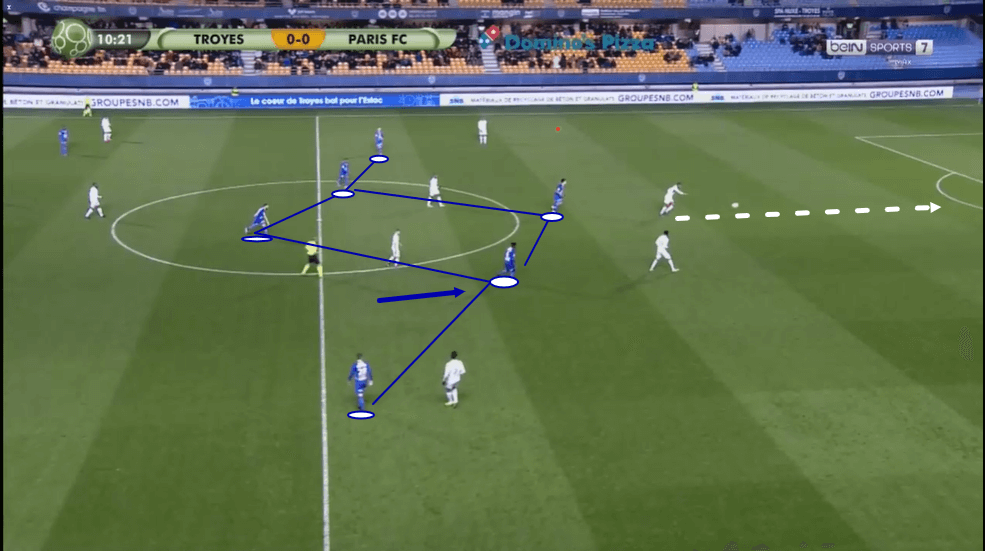
The image above provides us with an example of Troyes’ shape out of possession. Just prior to this image being taken, their opponents had attempted to build out from the back, however, they were forced to play the ball back to their goalkeeper as they struggled to build past Troyes’ first line of defence.
As we can see though, this defensive line isn’t positioned particularly high up the pitch. Troyes prefer to operate in more of a mid-block and their centre forward doesn’t usually take too much of an active role in attempting to force possession out of the opposition’s grasp.
It would be inaccurate to say that Troyes sit solely in a zonal marking system, however, this may be the case up until the opponents make their way up to the middle third of the pitch and begin attempting to build into Troyes’ half. At this point, their players do often appear to have some license to break out of their shape to an extent, in order to apply some pressure to the opposition, however, the shape is still very much zone-oriented.
We can see a small example of this in the image above. Just prior to this image being taken, the opposition had built up as far as the middle of the pitch, however, Troyes’ compact shape has congested the centre of the pitch, making it difficult for them to build through the midfield. Troyes’ right central midfielder then broke free of his position to threaten the opposition via his movement, subsequently forcing them to play the ball backwards.
Even when this central midfielder makes this movement, it doesn’t appear to really be with the intention of winning the ball back and these players are rarely seen actually attempting to engage with the opposition when they make these movements, however, this threatening movement, combined with the compact mid-block is often enough to prevent the opposition from progressing play any further, which Troyes are good at.
This explains why their PPDA is so high on average, however it also shows that they are still quite an effective team out of possession and their players are quite active in defence, even if Batlles appears to instruct his side to spend their energy in other ways than attempting to force turnovers of possession during this phase of play.
Troyes’ midfield tends to sit quite narrow in this phase of play which can result in some space opening up for the opposition out wide but Troyes usually don’t mind the opposition playing the ball into the wide areas as the ball being played out wide just beyond the halfway line acts as a pressing trigger for Troyes at times, with the team often becoming more active at attempting to engage with the opposition in closer proximity to their own goal.
Additionally, Troyes also tend to be more passive in defence when they’re winning. They made an average of 42.6 recoveries per game when losing last season, whilst they made an average of 33.82 recoveries per game when winning last season.
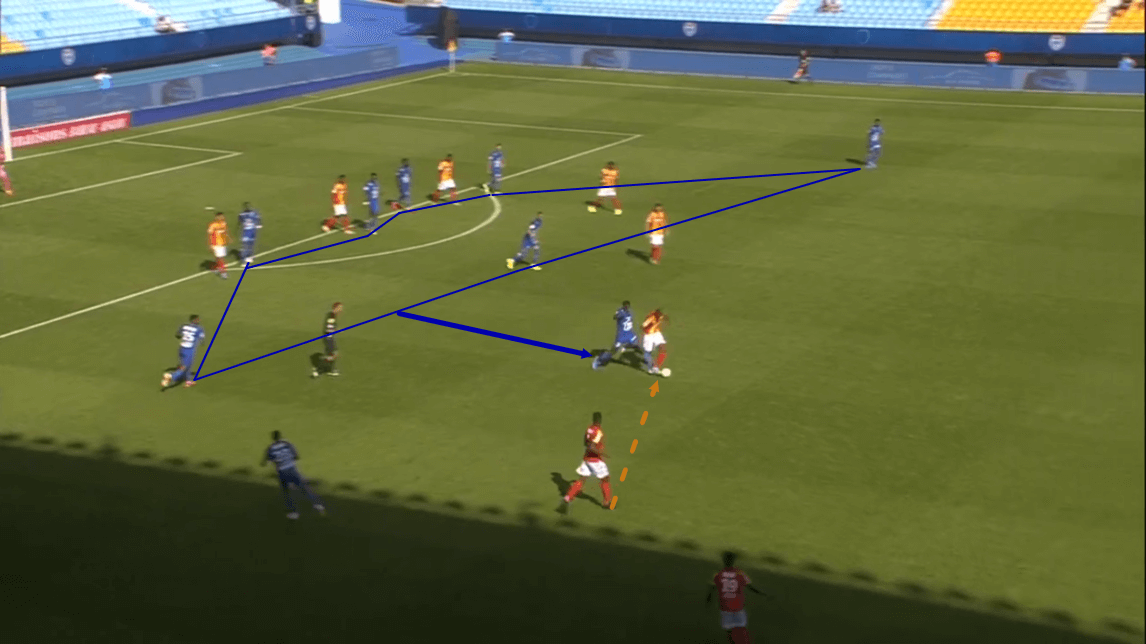
This next image above shows us an example of Troyes defending more aggressively when positioned deeper within their own half. They were also winning 1-0 at the time of this particular passage of play taking place.
As we can see, their defensive line is sitting quite narrow here, however, as the opposition play the ball from the left into the centre, this provokes a Troyes midfielder to vacate his deep position to close down the receiver.
This midfielder sticks a foot in and actually manages to dispossess the opposition player as soon as they receive this pass, providing us with an example of how Troyes’ players become more aggressive at applying pressure when positioned deeper within their own half, as opposed to when they are defending in the opposition’s half of the pitch.
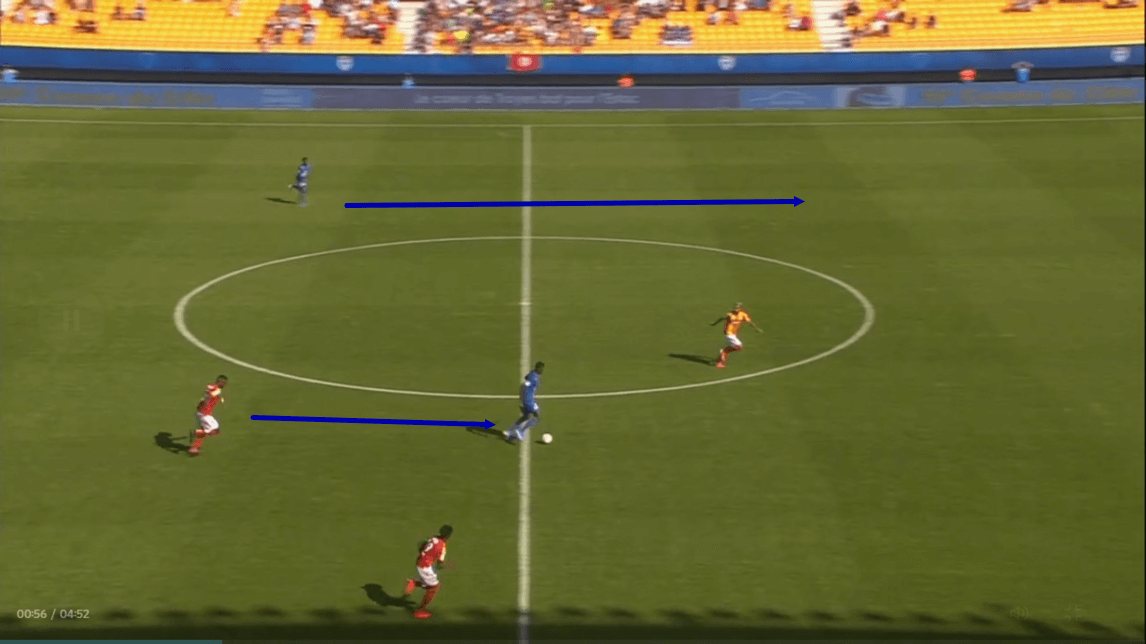
As this passage of play carries on, the ball winner goes on to bring the ball into the opposition’s half and as a teammate arrives in support, this creates a 2v1 advantage in favour of Troyes, which they can go on to exploit, scoring their second goal of this game.
This provides us with an example of Batlles’ apparent preference of defending more aggressively in deeper areas of the pitch as opposed to higher up the pitch, and his Troyes team’s effectiveness at doing so. This team possesses enough pace on the counterattack to cause problems for the opposition from this type of situation.
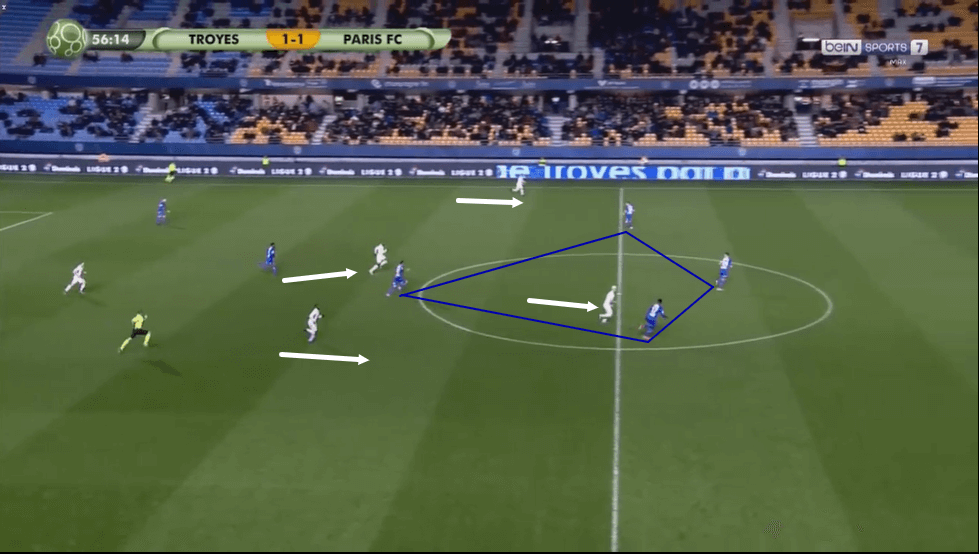
When Troyes attack, they often build from the centre out to the wing, as we touched on previously. As the ball makes its way out onto the wing, the near-side full-back often advances forward in support of the winger in possession. When he does this, the full-back on the opposite side tends to tuck in and join his centre-backs, whilst Troyes’ holding midfielder also maintains his position in front of the backline. This results in Troyes’ defence looking like it does in the image above.
It appears as though Batlles likes to attack with only one full-back going forward at a time, whilst he seems to like four players positioned in defence at all times. The full-back tucking in to join the centre-backs allows the backline to defend with a bit more width, should the opposition spring a counterattack, whilst the holding midfielder remaining at the back also provides Troyes with a bit more defensive cover.
The image above shows us an example of Troyes’ opponents setting off on a counterattack after a Troyes attack broke down. The opposition struggle to make them pay effectively on this occasion, however, as their attempted counterattack is slowed down thanks to Troyes’ effective defensive organisation and this diamond-like defensive shape which provides enough defensive cover to prevent the transition from attack to defence from being a major weakness in Batlles’ tactics.
In attack
Batlles’ philosophy of careful and precise passing plays a significant role in getting Troyes into attacking positions. However, their passing precision may be a detriment to their creativity in the final third at times, as despite having a high pass accuracy, Troyes only played an average of 2.01 key passes per game last term according to Wyscout, which is the third-lowest number of key passes that were played by any Ligue 2 side last season.
However, in addition to their tactics of playing carefully and accurately with their passes, Batlles’ side also take plenty of longshots when they build into the final third. Troyes are comfortable with shooting from distance and their midfielders can frequently be seen taking on long-range efforts. These efforts often come from areas in which key passes could be played which may also give us an indication as to why Troyes’ number of key passes per game is so low.
It would be impossible to discuss Troyes’ attacking tactics without discussing Maxime Barthelmé, who may have been the best playmaker in Ligue 2 last season, as he provided more assists than any other player in France’s second-tier during the 2019/20 campaign. It may be fitting that Batlles had Barthelmé in his Troyes side last season, considering that the manager was a UEFA Champions League-level attacking midfielder in his own right during his playing days, having faced off against the likes of Man United in that competition.

The playmaker featured in a variety of different offensive positions for Troyes last season and he was often given license to roam about the pitch in games. Just prior to this image above being taken, Barthelmé made his way from a position which was closer to the right-hand side of the pitch into this position in the left half-space, following a nice bit of link-up play with some of his fellow attacking teammates.
As he gets into this position, he can line up a cross which picks out one of his attackers in the box who subsequently slots the ball home. Batlles often deploys Barthelmé on the wings, however, he isn’t a particularly quick winger. Barthelmé is, essentially, a playmaker who is very gifted with the ball at his feet. His final ball is excellent, as is his decision-making and movement and Batlles takes advantage of this via the relatively free role that we often see him operate in.
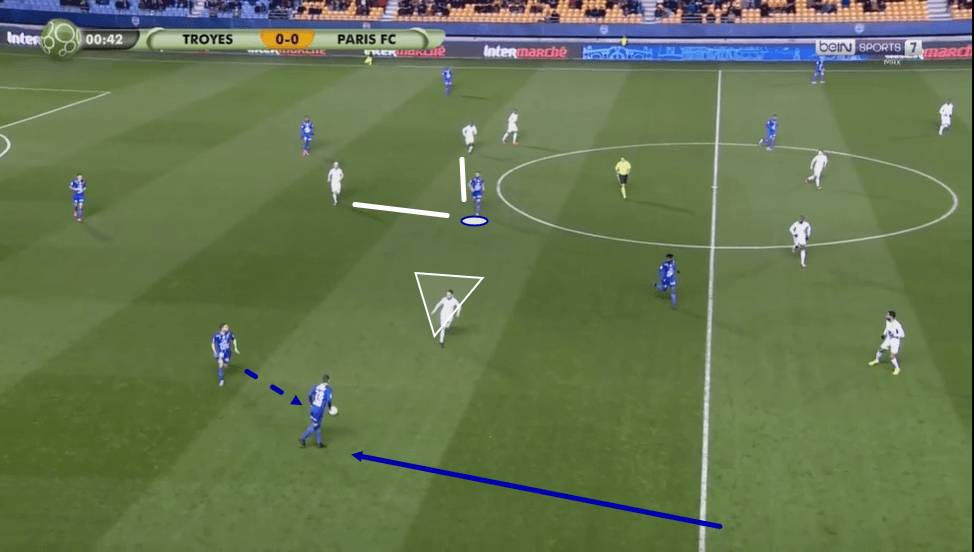
There may be no better example of Barthelmé operating with a large degree of freedom than this next passage of play that we can see beginning in this image above. We previously discussed how Batlles likes to build-up through his hilding midfielder, however, one weakness to this is that the opposition can then sit one or two players on this midfielder to mark him and make it more difficult for Troyes to play through him. This subsequently results in them being unable to force play through this player, which causes some disruption to their tactics.
One solution that Battles has apparently come up with for the problem of the holding midfielder being tightly marked, is to utilise Barthelmé’s technical quality and decision-making ability by allowing him to come deep in these situations and act as a deeper playmaker.
We previously discussed the importance of the holding midfielder being well-rounded in Battles’ system, however, Barthelmé also possesses a good degree of well-roundedness with regard to his technical, mental, and physical ability that makes him suited for operating in the deep playmaker role in the absence of the holding midfielder, as he does in the most recent image above.
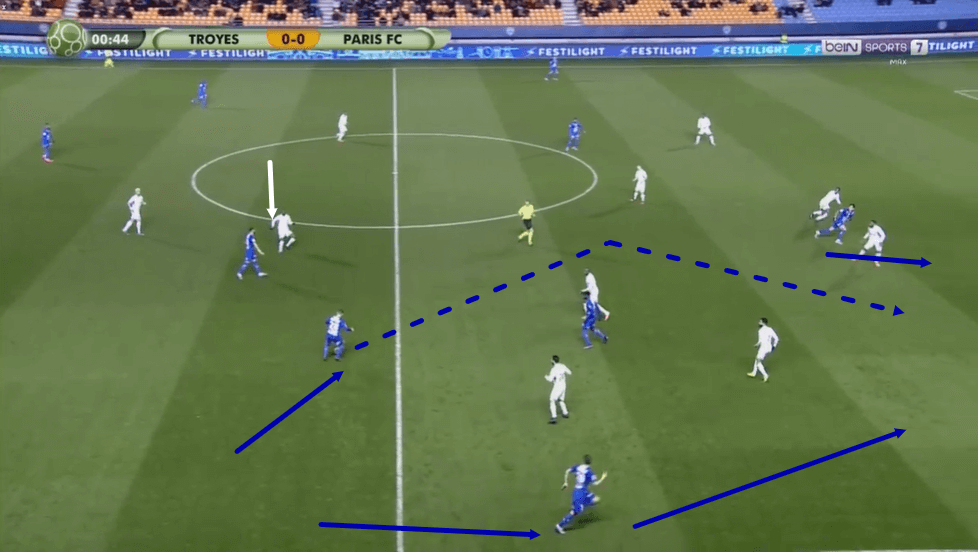
As play moves on, we see that the opposition continue to mark Troyes’ holding midfielder tightly, whilst Barthelmé moves inside, picking up a position deep on the right of central midfield from where he can play a ball over the top of the opposition defence and set his team off on an attack, illustrating his effectiveness in this deeper role when he is required to play it.
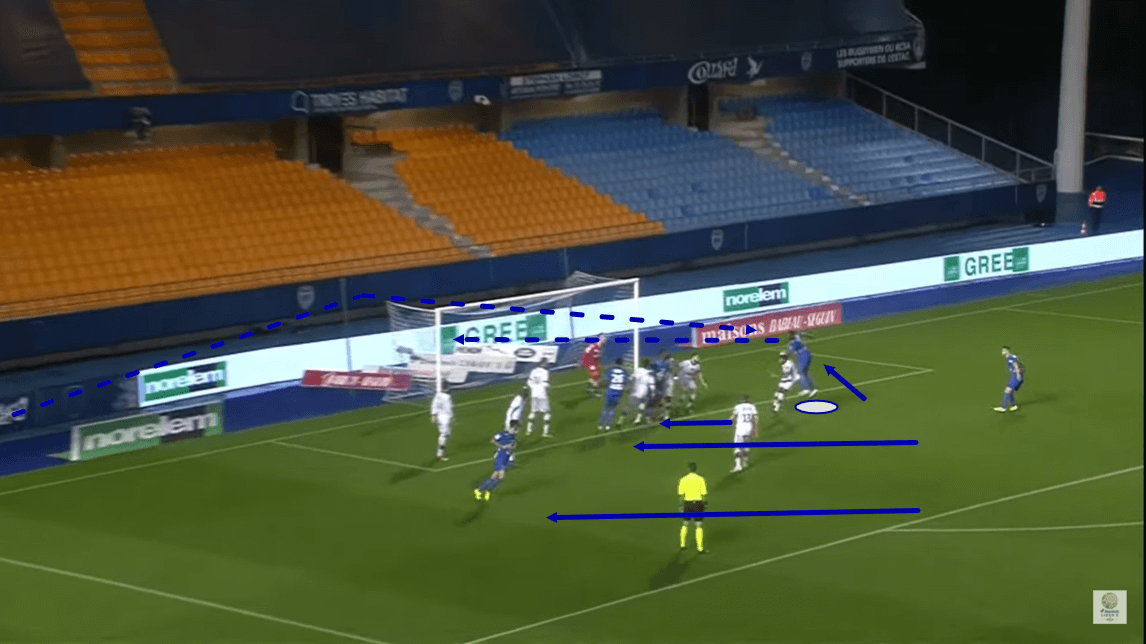
While Barthelmé is a very effective creator in open play, his set-piece delivery is a big part of his game which Battles undoubtedly made a key part of his tactics last term. Barthelmé’s left foot is a dangerous weapon and Battles has taken advantage of it via his set-pieces. Additionally, 192cm tall centre-back Boubakar Kouyaté was used effectively from set-pieces, such as the one in the image above, as he managed to score a total of five Ligue 2 goals last season, making him Troyes’ top goalscorer despite playing as a defender.
Kouyaté often occupies this type of position from corner kicks and indirect free kicks and Barthelmé is often precise enough with his delivery to find the big centre-back. This combination proved very effective for Troyes last term and played a big role in Barthelmé becoming Ligue 2’s top assist provider as well as Kouyaté becoming Troyes’ top goalscorer.
Batlles did well to take advantage of Barthelmé’s playmaking quality in a variety of different creative ways last season, whilst he also did well to maximise Kouyaté’s aerial threat.
Conclusion
To conclude this tactical analysis of Laurent Batlles, it may be fair to say that his 2019/20 campaign with Troyes wasn’t a bad start to life in senior management. He has shown some promising signs thus far and after ultimately finishing in fourth place last season, he will likely have promotion to Ligue 1 in his sights for next season.
In possession, Batlles’ side were patient and careful, opting to utilise more accurate short passes than long balls. Out of possession, Troyes were fairly passive for the most part last season, though they did display their ability to press more aggressively in deeper areas of the pitch. The individual quality of Barthelmé and Kouyaté was also honed well by Batlles last season.





Comments